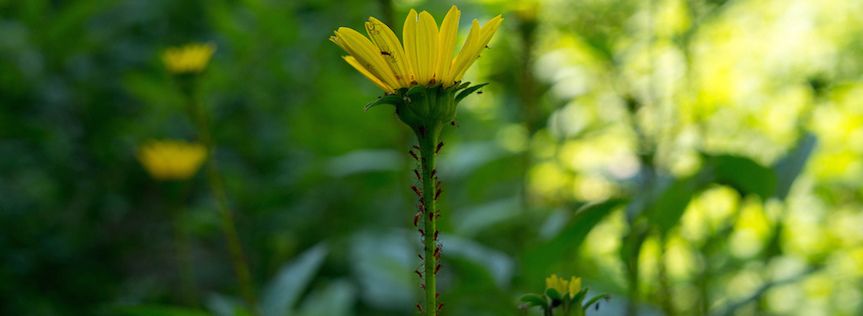Tips & Inspiration
Our library of gardening resources on topics ranging from seed starting to perennial care and beyond!
Click HereAll High Mowing Organic Seeds now 15% off, while supplies last!

Few things disrupt the beauty of a garden and the pleasure of a warm summer day more than the discovery of pests. From large animals to tiny insects, pests pose problems that range from minor annoyances to serious damage, and the everyday gardener may not always know the best way to deal with specific nuisances. We’re here to help with that.
In Part Two of our series we’ll showcase the best ways to deter some of the most common pests from the insect kingdom for Atlantic Canadian gardeners: aphids, leatherjackets and grubs.
Aphids can be found on flowers, vegetables, ornamental trees and shrubs. The average aphid is very small (around 2mm in size) and come in a variety of colors. The miniscule insects operate by sucking sap out of plants with their mosquito-like mouths, which can cause the affected plant to “yellow”, wilt, and have stunted growth. In small numbers they aren’t harmful to a healthy plant, but can be disruptive when in large groups. Aphids are typically found grouped on flower buds or on the undersides of leaves.
Fabric coverings are an excellent way to prevent aphids from getting into your garden. Our Plant & Seed Guard protects plants from a host of insects while still allowing sunlight and air in. If aphids do manage to infest in your garden, there are multiple methods available for removing them.
Directly spraying infected plants with water will cause aphids to slide off their host and onto the ground. This can wet and inhibit the wings of certain flying aphids and makes the return to the plant difficult due to their small size and their susceptibility to predators once they are in the grass. Similarly, going through and removing aphids by hand works as well. If a particular part of a large plant has aphids, pruning is another option; plants with aphids only need to be removed from your garden when they are already wilted or yellow.
A trap you can consider implementing in your garden is Safer’s Sticky Stiks. The yellow colour of the trap attracts aphids and glues them to the paper, preventing them from damaging your plants.
For a biological solution, we carry bags of 1000 to 4500 ladybugs that will certainly take care of your aphid problem. Ladybugs love eating aphids and our customers are always surprised at the effectiveness of these helpful beetles. Come in to talk to our garden experts on how to best introduce our ladybugs into your garden!
Aphids only become a serious problem if you let them; regularly monitoring your garden for signs of aphids can prevent them from causing any lasting harm.
Leatherjackets are the larvae of the crane fly, known by their more common name, ‘Daddy Long Legs’. These small brown grubs can be extremely destructive to lawns and gardens. They are laid in early fall by the crane fly in grass, and they eat the roots of grass until early June of the following year. The appetite of a leatherjacket is quite remarkable, and their presence is indicated by browning or dead grass. Birds pecking over dead patches of grass is another good indication that leatherjackets are in your soil.
In combatting leatherjackets, using Nematodes is your best bet. Nematodes are types of microscopic worms that make their home in your soil. They are an incredibly diverse bunch and while some are very dangerous to plants, others kill harmful larvae. One type of Nematodes we carry targets leatherjackets specifically and thoroughly eradicates them. More information and directions on applying nematodes can be found on our product page, here.
In a similar vein to leatherjackets, White grubs are the larvae of the infamous (at least here in Atlantic Canada) June bugs. Usually 4 centimetres in length with an off-white body and a darker head, the White grub is a common enemy to those of us who cherish our lawns. Their lifespan follows a 3-year cycle and for the first 2 years they remain nestled in your soil soil, feeding on grass roots during summer and burrowing deep into the ground when things get chilly. In that fated third summer they transform into June bugs, lay more larvae, and continue the cycle.
Healthy fertilized and watered grass is the best way to keep white grub from infesting your lawn. June bugs look for thin, bare grass patches when laying their larvae, and prefer to stay away from green lawns.
If white grubs do pay a visit to your yard, Nematodes are, again, the best answer. Biological methods like Nematodes are much safer than pesticides and work very efficiently at destroying the grubs; consider using our Grub Killer Beneficial Nematodes.
Our library of gardening resources on topics ranging from seed starting to perennial care and beyond!
Click HereHave questions? We have answers! Send us a message and we'll be here to help every step of the way.
Click Here